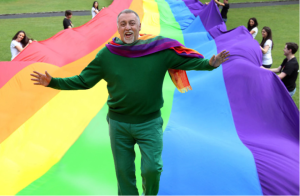
Courtesy Of Tony Maxwell
/
Gilbert Baker Foundation
Gilbert Baker was born on June 2nd, 1951 in Kansas. At an early age he found refuge in art, but his parents discouraged him from pursuing it. Baker wrote: “But this, after all, was Kansas in 1956… Being an artist was bad in the same way that homosexuality was bad. When I first told my parents that I wanted to be an artist, they responded in extremely negative terms. It was as if I had told them I was also gay.”
His parents were a little less reluctant when Baker won an art contest and a scholarship to an art academy. Despite this, Baker was not happy in Kansas. He saw a way out when he was drafted into the army on his 19th birthday. During his induction process, he was questioned by a sergeant during the sexuality screening. “Are you a homosexual?” Baker responded by saying “no”– a lie he was no stranger to telling. The sergeant responded, “Are you sure? You sound like one.” Baker continued to deny it, as the sergeant threatened him with dishonorable discharge and homophobic slurs. Baker maintained that he was not gay, and the sergeant finally signed off on him.
Gilbert Baker’s experience only got worse. During basic training, he was subject to more homophobic harassment from superior officers. One day, after failing to hit the target on the firing range, a drill sergeant removed Baker from his group and put a watermelon in front of the target. He shot at the melon until it exploded and explained that this is what happens to gay people in the army: “they die.”
Feeling fed up with this treatment, Baker was called unto the staff sergeant’s office, who saw his frustrations. He encouraged him to become a medic. He excelled in his courses, and soon became a nurse.
In 1970, Baker moved to Oakland to continue working as a military medic. When he wasn’t working, he spent time with a friend, Jim. Jim was a soldier who lived in the same barracks and worked as a medic in the same facility as Baker. They spent their time “walking across the Golden Gate Bridge or hiking to the top of the Marin Headlands just to take in its breathtaking sights.” Together, they explored the forest and beaches of the Presidio and different neighborhoods in the city. The two soon fell in love, but Jim was afraid of being caught. After completing their nursing programs, they were sent to different hospitals. Jim went to Okinawa and Baker was stationed in San Francisco.
“I dreamed about him every night,” said Baker. “A while later, I heard from a friend that Jim had gotten married and gone back to Tennessee. I cried, but I wasn’t going to go back into the closet and get married like him. I was not going to lie about being gay anymore. Falling in love with Jim had changed me. The power of love opened my closet door.” Gilbert Baker came out to his family, and they disowned him.
He was eventually honorable discharged form the military in 1972 and stayed in San Francisco. He volunteered with the San Francisco Gay Community Center, and joined the graphics committee. In response to Harvey Baker, the first openly gay person to be elected to office’s, victory in 1977 Baker was inspired to create a new symbol for the LGBTQ+ community. “We all felt that we needed something that was positive, that celebrated our love,” said Baker. He was inspired by flags and the connections they had to identity, nationhood and revolution. He decided on a rainbow, to represent the magic and diversity of his community. Gilbert Baker and a team two 60 x 30 feet Rainbow Flags, for The Gay Freedom Day Parade on June 25th 1978.
5 months later, Harvey Milk was assassinated. This was a tremendous loss for the community. Hate crimes against LGBTQ+ people increased. Baker was attacked on the streets of San Francisco, when he reported it to the police, they laughed. In the wake of these tragedies, Baker wanted to make the 1979 Gay Freedom Day Parade bigger than ever by covering the street with rainbow flags. He could not achieve this feat on his own, so he commissioned a local flag company called Paramount Flags to help create four hundred Rainbow Flags to line the streets during the parade. After the 1979 parade the popularity of the Rainbow Flag only continued.
For the rest of his life, Gilbert Baker pushed boundaries and was an advocate for the LGBTQ+ community. When Marriage Equality was legalized, historic places around the world were lit up in rainbow, including the White House. In 2016, Gilbert Baker was invited to the White House to personally present President Barack Obama with a small hand dyed Rainbow Flag. On March 31, 2017 he passed away at 65 years old.
A&E Networks Television. (n.d.). Biography.com. https://www.biography.com/activist/gilbert-baker-pride-flag
Online exhibition – gilbert baker. GLBT Historical Society. (n.d.). https://www.glbthistory.org/gilbert-baker#meet-gilbert
U.S. Department of the Interior. (n.d.). Gilbert Baker (U.S. National Park Service). National Parks Service. https://www.nps.gov/people/gilbert-baker.htm